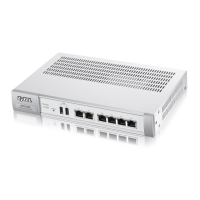Chapter 10 Policy and Static Routes
NXC Series User’s Guide
179
Figure 94 Configuration > Network > Routing > Policy Route
The following table describes the labels in this screen.
Table 75 Configuration > Network > Routing > Policy Route
LABEL DESCRIPTION
Show / Hide
Advanced
Settings
Click this button to display a greater or lesser number of configuration fields.
Use IPv4 Policy
Route to
Override Direct
Route
Select this to have the NXC forward packets that match a policy route according to the policy
route instead of sending the packets directly to a connected network.
Add Click this to create a new entry. Select an entry and click Add to create a new entry after the
selected entry.
Edit Double-click an entry or select it and click Edit to open a screen where you can modify the
entry’s settings.
Remove To remove an entry, select it and click Remove. The NXC confirms you want to remove it before
doing so.
Activate To turn on an entry, select it and click Activate.
Inactivate To turn off an entry, select it and click Inactivate.
Move To change a rule’s position in the numbered list, select the rule and click Move to display a field
to type a number for where you want to put that rule and press [ENTER] to move the rule to the
number that you typed.
The ordering of your rules is important as they are applied in order of their numbering.
# This is the number of an individual policy route.
Status This icon is lit when the entry is active and dimmed when the entry is inactive.
Description This is the descriptive name of the policy route.
User This is the name of the user (group) object from which the packets are sent. any means all users.
Schedule This is the name of the schedule object. none means the route is active at all times if enabled.
Incoming This is the interface on which the packets are received.
Source This is the name of the source IP address (group) object. any means all IP addresses.
Destination This is the name of the destination IP address (group) object. any means all IP addresses.

